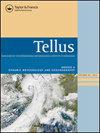全球公里尺度模式中的大气能谱
IF 1.3
4区 地球科学
引用次数: 9
摘要
对水平分辨率小于9 km的5种不同全球模式的11次40天的积分进行了全球能量谱的比较。采用正态函数分解的方法区分平衡罗斯比波;RW)和不平衡(惯性-重力波;IGW)循环。模拟得到了预期的典型光谱形状,但它们在中尺度上的光谱斜率以及RW和IGW光谱相交的纬向尺度存在显著差异。将总波能划分为RWs和igw对湍流闭合方案最为敏感,这种划分决定了模拟中的谱交叉尺度,其差异可达两倍。这意味着在使用简单的空间滤波来比较风暴分辨模拟中的重力波现象时必须小心,即使模型水平分辨率相似。与RWs和igw之间的能量分配相反,湍流关闭方案的变化似乎不会强烈影响光谱斜率,光谱斜率只在中尺度上表现出主要差异。尽管它们对全球(水平动能加上可用势能)的贡献很小,但小尺度对驱动全球平均环流很重要。我们的研究结果支持了以前的研究结论,即对流强度是解释小尺度能量差异的一个相关因素。这里研究的模式产生了热带降水模式的主要大尺度特征。然而,特别是在水平波数较大的情况下,对流层上层垂直速度谱在能量上存在三倍或三倍以上的差异。对流层上层垂直速度谱是深对流强度的良好指标。小尺度的高垂直动能多见于不使用任何对流参数化的模式。本文章由计算机程序翻译,如有差异,请以英文原文为准。
Atmospheric Energy Spectra in Global Kilometre-Scale Models
Eleven 40-day long integrations of five different global models with horizontal resolutions of less than 9 km are compared in terms of their global energy spectra. The method of normal-mode function decomposition is used to distinguish between balanced (Rossby wave; RW) and unbalanced (inertia-gravity wave; IGW) circulation. The simulations produce the expected canonical shape of the spectra, but their spectral slopes at mesoscales, and the zonal scale at which RW and IGW spectra intersect differ significantly. The partitioning of total wave energies into RWs an IGWs is most sensitive to the turbulence closure scheme and this partitioning is what determines the spectral crossing scale in the simulations, which differs by a factor of up to two. It implies that care must be taken when using simple spatial filtering to compare gravity wave phenomena in storm-resolving simulations, even when the model horizontal resolutions are similar. In contrast to the energy partitioning between the RWs and IGWs, changes in turbulence closure schemes do not seem to strongly affect spectral slopes, which only exhibit major differences at mesoscales. Despite their minor contribution to the global (horizontal kinetic plus potential available) energy, small scales are important for driving the global mean circulation. Our results support the conclusions of previous studies that the strength of convection is a relevant factor for explaining discrepancies in the energies at small scales. The models studied here produce the major large-scale features of tropical precipitation patterns. However, particularly at large horizontal wavenumbers, the spectra of upper tropospheric vertical velocity, which is a good indicator for the strength of deep convection, differ by factors of three or more in energy. High vertical kinetic energies at small scales are mostly found in those models that do not use any convective parameterisation.
求助全文
通过发布文献求助,成功后即可免费获取论文全文。
去求助
来源期刊
CiteScore
4.00
自引率
5.00%
发文量
21
审稿时长
3 months
期刊介绍:
Tellus A: Dynamic Meteorology and Oceanography along with its sister journal Tellus B: Chemical and Physical Meteorology, are the international, peer-reviewed journals of the International Meteorological Institute in Stockholm, an independent non-for-profit body integrated into the Department of Meteorology at the Faculty of Sciences of Stockholm University, Sweden. Aiming to promote the exchange of knowledge about meteorology from across a range of scientific sub-disciplines, the two journals serve an international community of researchers, policy makers, managers, media and the general public.
Original research papers comprise the mainstay of Tellus A. Review articles, brief research notes, and letters to the editor are also welcome. Special issues and conference proceedings are published from time to time.
The scope of Tellus A spans dynamic meteorology, physical oceanography, data assimilation techniques, numerical weather prediction, climate dynamics and climate modelling.

 求助内容:
求助内容: 应助结果提醒方式:
应助结果提醒方式:


